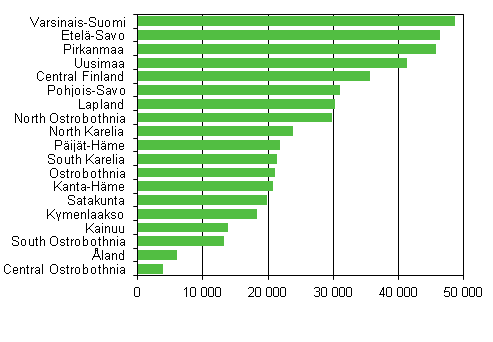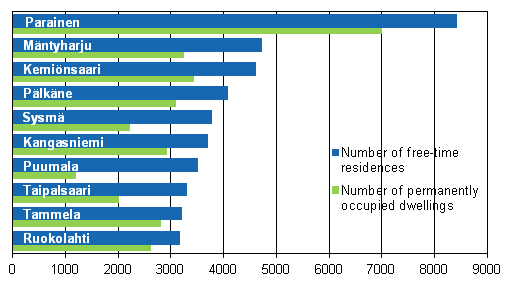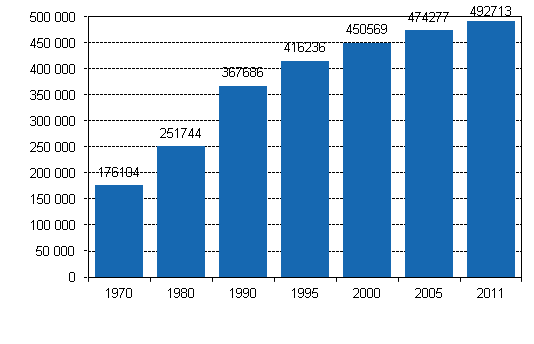Free-time Residences 2011
Parainen is the municipality with highest number of free-time residences 2011
According to Statistics Finland, there were 492,700 free-time residences in Finland at the end of 2011. In terms of absolute numbers, the municipality of Parainen had the highest quantity of free-time residences, or over 8,000. Hämeenlinna, Kouvola, Salo, Kuopio,Kuusamo and Raasepori had the next largest numbers of free-time residences. In each of them the stock of free-time residences exceeded 6,000. As a result of municipal mergers, the number of free-time residences in many urban municipalities rather describes the volume of summer housing in the region than free-time residences located in the urban area.
Table 1. Highest number of free-time residences, 31 December 2011
| (Regional Division based on Municipalities on 1 Jan. 2012) | Number of free-time residences |
| Parainen | 8 425 |
| Hämeenlinna | 7 731 |
| Kouvola | 7 669 |
| Salo | 7 116 |
| Kuopio | 6 604 |
| Kuusamo | 6 518 |
| Raasepori | 6 366 |
| Mikkeli | 5 812 |
| Mäntyharju | 4 738 |
| Kemiönsaari | 4 618 |
Varsinais-Suomi was the region with the highest number of free time residences in 2011
Varsinais-Suomi was the region with the highest number of free time residences, i.e. 48,600. Etelä-Savo and Pirkanmaa also had more than 45,000 free-time residences. The numbers of free-time residences were lowest in the regions of Central Ostrobothnia (3,900) and Åland (6,000).
Figure 1. Free-time residences by region 2011

The density of free-time residences in the municipality can also be described by comparing their number with that of permanently occupied dwellings. Then the municipalities richest in free-time residences were places that had a relatively low number of population and a high number of free-time residences. At the end of 2011, altogether 58 municipalities had more free-time residences than permanently occupied dwellings. Such municipalities were Parainen, Mäntyharju, Kemiönsaari and Pälkäne. As the number of permanent residents decreases, the number of free-time residences may become emphasised in ever more municipalities. From 2000 onwards, the number of municipalities with a majority of free-time residences has increased approximately by ten, when the situation is viewed with the present division of municipalities of 2012.
Figure 2. Municipalities with more free-time residences than occupied dwellings in 2011 (municipalities with the highest number of free-time residences)

Stock of free-time residences grew fastest in the 1980s
There were 492,700 free-time residences in Finland at the end of 2011. The number increased by 3,500 from the previous year. The stock of free-time residences does not grow direct due to newbuilding because some free-time residences area converted into permanent dwellings or their active use is discontinued. The number of free-time residences grew fastest in the 1980s. In 1990, there were 368,000 free-time residences, which was 46 per cent more than in 1980. From 1970 to 1980, the increase was 75,600, or 43 per cent.
Figure 3. Number of free-time residences 1970–2011

Under 4,000 new free-time residences completed per year
Over 4,000 new free-time residential buildings have been completed per year in the 2000s. In the 2010s the number of new free-time residential buildings has decreased under 4,000 per year. For example, 3,600 new free-time residential building were completed in 2011 (according to statistics of buildingstock). The pace of construction of free-time residences has been slowing down steadily since the early years of the 1990s. Whereas roughly 8,000 free-time residences were built every year in the early 1990s, in recent years the number has been half of this. Through the 1990s, the stock of free-time residences grew by around 20 per cent. This is clearly by less than in the 1970s and 1980s, when the stock increased by over 40 per cent per decade.
Building of free-time residences liveliest in Lapland, Etelä-Savo and Varsinais-Suomi
In 2011 the building of free-time residences has been liveliest in Etelä-Savo and Lapland. In the 2000s, the highest numbers of free-time residential buildings have been completed in general in Lapland, Etelä-Savo and Varsinais-Suomi where their number has approximately 400 per year.
Since 1990 the stock of free-time residences has grown most in Etelä-Savo, where it has increased by 12,000. The stock has changed least in Central Ostrobothnia and Åland where the number of free-time residences has increased by over 1,000 since 1990.
Summer residence densest in Kustavi and Kaskinen
Free-time residences are densest in the municipality of Kustavi and Kaskinen with average 17–18 free-time residences per square kilometre of land. In eight municipalities there are more than ten free-time residences per square kilometre. In the whole country there are, on the average, 1.6 free-time residences per square kilometre. Varsinais-Suomi, Uusimaa and Päijät-Häme have more than four free-time residences per square kilometre. In South, North and Central Ostrobothnia, and Kainuu and Lapland there is average less than one free-time residence per square kilometre. In proportion to the land area, Kauniainen, Savukoski, Utsjoki, Enontekiö, Sodankylä, Kärsämäki and Inari have the lowest number of free-time residences.
Avarage floor area of free-time residences 48 square metres
There are relatively large size differences between new and old free-time residences. The average floor area of the free-time residences built in 2000-2011 was 65 square metres whereas the average floor area of free-time residences built prior to this was 44 square metres. The median was 40 square metres. On the other hand, nearly one free-time residence in four had a floor area of 60 square metres or more.
Table 2. Free-time residences by floor area in 2011
| Floor area, m2 | Number of free-time residences | % |
| Free-time residences, total | 492 713 | 100.0 |
| – 19 | 41 557 | 8.4 |
| 20 – 39 | 178 561 | 36.2 |
| 40 – 59 | 132 425 | 26.9 |
| 60 – 79 | 60 820 | 12.3 |
| 80 – 99 | 27 529 | 5.6 |
| 100 – | 26 683 | 5.4 |
| Unknown | 25 138 | 5.1 |
| Average floor space | 48 | .. |
Almost 800 000 Finns belong to household- dwelling unit with a free-time residence
Of all free-time residences, 405,000 were owned by private persons, while 88,000 were owned by companies, communities and deceased’s estates, or by foreigners. In all, 786,000 persons belonged to a household-dwelling unit which owns a free-time residence. Free-time residences are generally located near the place of permanent residence. Two-thirds of free-time residence owners had a free-time residence in their region of residence. One-third of free-time residence owners had a free-time residence in their municipality of domicile.
Summer residents increase the population of municipalities in summer
Summer residents travelling to free-time residences outside their municipality of domicile totalled approximately 530,000. Etelä-Savo had the highest number of summer residents, or over 55,000. In summer, over 10,000 persons may spend time on their free-time residences in Parainen, the municipality with the largest number of summer residents. Summer residents in Hämeenlinna, Salo, Raasepori and Mäntyharju also number over 6,000. However, the largest relative increase took place in Kustavi, where the inclusion of summer residents increases the municipality's population from just under one thousand to over five thousand. Summer residents more than double the population of altogether 13 municipalities.
Average age of a free-time residence owners is 62 years
The average age of owners of new free-time residences completed in 2011 was 54 years. The average age of all free-time residence owners was 62. Of all free-time residence owners, 23,000 or just six per cent were aged under 40. Over 40 per cent of all free-time residences were owned by a household-dwelling unit of two adults and only 14 per cent by households with children aged under 18.
Source: Buildings and Free-time Residences, Statistics Finland
Inquiries: Marja Hermiö 09 1734 3211, Arja Tiihonen 09 1734 3272, Elina Aspblad-Huohvanainen 09 1734 3232, asuminen@stat.fi
Director in charge: Jari Tarkoma
Updated 25.5.2012
Official Statistics of Finland (OSF):
Buildings and free-time residences [e-publication].
ISSN=1798-6796. 2011,
Free-time Residences 2011
. Helsinki: Statistics Finland [referred: 14.12.2025].
Access method: http://stat.fi/til/rakke/2011/rakke_2011_2012-05-25_kat_001_en.html

